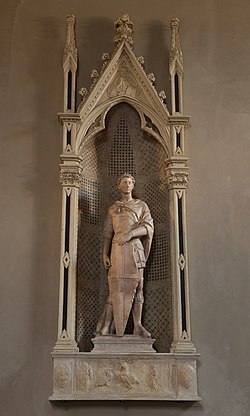
Donato di Niccolò di Betto Bardi, known mononymously as Donatello, was an Italian sculptor of the Renaissance period. Born in Florence, he studied classical sculpture and used his knowledge to develop an Early Renaissance style of sculpture. He spent time in other cities, where he worked on commissions and taught others; his periods in Rome, Padua, and Siena introduced to other parts of Italy the techniques he had developed in the course of a long and productive career. His David was the first freestanding nude male sculpture since antiquity; like much of his work it was commissioned by the Medici family.
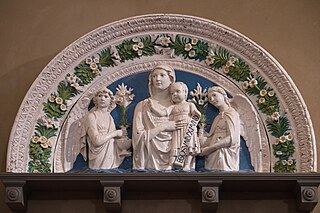
Luca della Robbia was an Italian Renaissance sculptor from Florence. Della Robbia is noted for his colorful, tin-glazed terracotta statuary, a technique that he invented and passed on to his nephew Andrea della Robbia and great-nephews Giovanni della Robbia and Girolamo della Robbia. Although a leading sculptor in stone, after developing his technique in the early 1440s he worked primarily in terracotta. His large workshop produced both less expensive works cast from molds in multiple versions, and more expensive one-off individually modeled pieces.
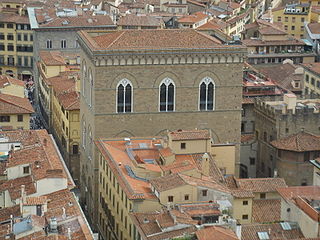
Orsanmichele is a church in the Italian city of Florence. The building was constructed on the site of the kitchen garden of the monastery of San Michele which no longer exists.

Jacopo della Quercia, also known as Jacopo di Pietro d'Agnolo di Guarnieri, was an Italian sculptor of the Renaissance, a contemporary of Brunelleschi, Ghiberti and Donatello. He is considered a precursor of Michelangelo.

Nanni d'Antonio di Banco was an Italian Renaissance sculptor from Florence. He was a contemporary of Donatello – both are first recorded as sculptors in the accounts of the Florence Duomo in 1406, presumably as young masters.

Desiderio da Settignano, real name Desiderio de Bartolomeo di Francesco detto Ferro was an Italian Renaissance sculptor active in north Italy.

David is a bronze statue of the biblical hero by the Italian Early Renaissance sculptor Donatello, probably made in the 1440s. Nude except for helmet and boots, it is famous as the first unsupported standing work of bronze cast during the Renaissance, and the first freestanding nude male sculpture made since antiquity. It depicts David with an enigmatic smile, posed with his foot on Goliath's severed head just after defeating the giant. The youth is completely naked, apart from a laurel-topped hat and boots, and holds Goliath's sword.
Donatello's Saint Mark (1411–1413) is a marble statue that stands approximately 7 ft 9 in (2.36 m) high and is displayed in the museum of the Orsanmichele church, Florence. It originally was displayed in an exterior niche of the church, where a copy now stands. It depicts Mark the Evangelist.
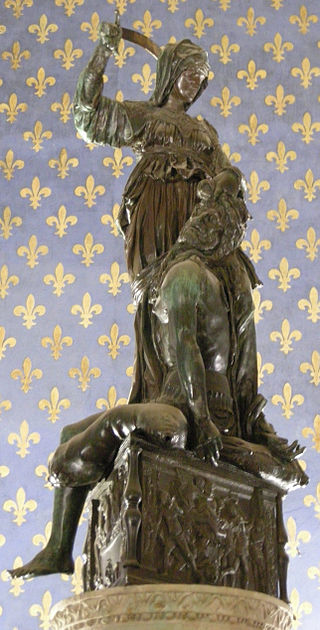
Judith and Holofernes (1457–1464) is a bronze sculpture created by the Italian Renaissance sculptor Donatello towards the end of his life and career. It is located in the Hall of Lilies, in the Palazzo Vecchio, Florence, Italy. A copy stands in one of the sculpture's original positions on the Piazza della Signoria, in front of the Palazzo Vecchio.

Christ and Saint Thomas (1467–1483) is a bronze statue by Andrea del Verrocchio made for one of the fourteen niches on the exterior walls of the Orsanmichele in Florence, Italy. It is now replaced in that location by a cast and the original has been moved inside the building, which is now a museum. The sculpture shows the Incredulity of Saint Thomas, a subject frequently represented in Christian art since at least the 5th century and used to make a variety of theological points. Thomas the Apostle doubted the resurrection of Jesus and had to feel the wounds for himself in order to be convinced. The surrounding marble niche was originally designed by Donatello for his Saint Louis of Toulouse (1413), but that statue was moved to Santa Croce when the niche was sold to the Tribunale di Mercanzia, who commissioned the replacement from Verrocchio.

Baccio da Montelupo, born Bartolomeo di Giovanni d'Astore dei Sinibaldi, was a sculptor of the Italian Renaissance. He is the father of another Italian sculptor, Raffaello da Montelupo. Both father and son are profiled in Vasari's Le Vite delle più eccellenti pittori, scultori, ed architettori.
Saint George Freeing the Princess is a marble stiacciato bas-relief sculpture by Donatello, sculpted around 1416 or 1417. It was originally situated under the same artist's Saint George on an external niche of the church of Orsanmichele in Florence; both works are now in the Bargello Museum, with replicas replacing them in their original positions.

The Madonna of the Rose is a 2.2 metre high marble sculpture of the Madonna and Child enthroned, with the Child trying to take a bunch of rosa canina from his mother's hand. It forms part of a cycle of fourteen sculptures of the patron saints of the guilds of Florence on the external niches of the Orsanmichele church. No documents survive to precisely date it, leading to several theories and attributions. Most art historians attribute it to Pietro di Giovanni Tedesco, a German or Flemish sculptor active in Florence in the sculpture-yard of Florence Cathedral. It shows similarities to late works from the school of Giotto.

Saint Philip is an Apuan marble statue of Philip the Apostle by Nanni di Banco. It forms part of a cycle of fourteen sculptures commissioned for the external niches of Orsanmichele in Florence, each showing the patron saint of one of the city's guilds. It is 2.5 m high and was commissioned by the Arte dei Calzolai. Completed around 1410-1412, it is now in the Museo di Orsanmichele, although a replica fills its original niche.
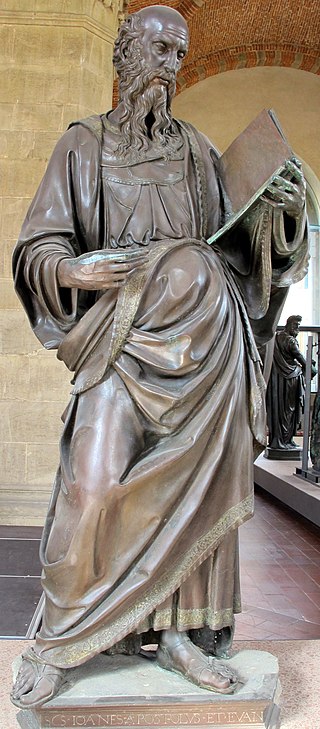
Saint John the Evangelist is a 2.66 m high bronze statue of John the Evangelist by Baccio da Montelupo, completed in 1515. It was commissioned by the Arte della Seta as part of a cycle of fourteen sculptures for the external niches of Orsanmichele, each showing the patron saint of one of the guilds of Florence. It is now in the Museo di Orsanmichele, although a replica fills its original niche.

Saint Luke is a 2.73 m high bronze statue of Luke the Evangelist by Giambologna, commissioned by the Arte dei Giudici e Notai and completed in 1597–1602. One of a cycle of fourteen commissioned by the guilds of Florence for the external niches of Orsanmichele, it is now in the Museo di Orsanmichele, although a replica fills its original niche.
Saint Peter is a Apuan marble sculpture of Saint Peter of 2.43 m high. It is attributed to Filippo Brunelleschi and his style is influenced by Donatello. It forms part of a cycle of fourteen statues of the patron saints of the guilds of Florence for the external niches of Orsanmichele. The sculpture of St Peter was completed for the Arte dei Beccai (butchers) guild around 1412 and is now in the Museo di Orsanmichele, although a replica fills its original niche.

Saint Louis of Toulouse is a gilded bronze sculpture of Louis of Toulouse by Donatello with a marble niche all'antica on the facade of Orsanmichele, executed in 1423–1425. It is now in the refectory of the Museo di Santa Croce in Florence.

Italian Renaissance sculpture was an important part of the art of the Italian Renaissance, in the early stages arguably representing the leading edge. The example of Ancient Roman sculpture hung very heavily over it, both in terms of style and the uses to which sculpture was put. In complete contrast to painting, there were many surviving Roman sculptures around Italy, above all in Rome, and new ones were being excavated all the time, and keenly collected. Apart from a handful of major figures, especially Michelangelo and Donatello, it is today less well-known than Italian Renaissance painting, but this was not the case at the time.

Nanni di Bartolo, also known as "il Rosso", was a Florentine sculptor of the Early Renaissance, a slightly younger contemporary of Donatello. His dates of birth and death are not known, but he is recorded as an active master from 1419 to 1451.
